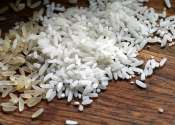New way of cooking rice removes arsenic and retains mineral nutrients, study shows
Cooking rice in a certain way removes over 50 percent of the naturally occurring arsenic in brown rice, and 74 percent in white rice, according to new research.

Cooking rice in a certain way removes over 50 percent of the naturally occurring arsenic in brown rice, and 74 percent in white rice, according to new research.
Environment
Nov 2, 2020
7
18911

(Phys.org) —Researchers at India's Institute of Technology Madras have developed a new kind of portable water purification system based on nanoparticle filtration. In their paper published in the Proceedings of the National ...

Caltech scientists have discovered a new species of worm thriving in the extreme environment of Mono Lake. This new species, temporarily dubbed Auanema sp., has three different sexes, can survive 500 times the lethal human ...
Plants & Animals
Sep 26, 2019
4
6049

Most Americans take it for granted that the water that comes out of their taps is clean and safe to drink.
Environment
Oct 4, 2023
1
467

Rice is the most widely consumed staple food source for a large part of the world's population. It has now been confirmed that rice can contribute to prolonged low-level arsenic exposure leading to thousands of avoidable ...
Environment
Aug 4, 2020
0
863

Two new scientific papers have disproved a controversial claim made by NASA-funded scientists in 2010 that a new form of bacterial life had been discovered that could thrive on arsenic.
Cell & Microbiology
Jul 9, 2012
15
2

(PhysOrg.com) -- Evidence that the toxic element arsenic can replace the essential nutrient phosphorus in biomolecules of a naturally occurring bacterium expands the scope of the search for life beyond Earth, according to ...
Space Exploration
Dec 2, 2010
27
0

High up in the high Andes mountains of Argentina, researchers have identified the first-ever evidence of a population uniquely adapted to tolerate the toxic chemical arsenic.
Evolution
Mar 3, 2015
1
1925

Why are gold deposits found at all? Gold is famously unreactive, and there seems to be little reason why gold should be concentrated, rather than uniformly scattered throughout the Earth's crust. Now, an international group ...
Nanomaterials
Jul 5, 2021
0
27

The Carlin-type gold deposits in Nevada, U.S., are the origin of five percent of the global production and 75 percent of the U.S. production of gold. In these deposits, gold does not occur in the form of nuggets or veins, ...
Earth Sciences
May 1, 2019
0
379
Arsenic (pronounced /ˈɑrsnɪk/; also /ɑrˈsɛnɪk/ when attributive) is the chemical element that has the symbol As and atomic number 33. Arsenic was first documented by Albertus Magnus in 1250. Its atomic mass is 74.92. Arsenic is a notoriously poisonous metalloid with many allotropic forms, including a yellow (molecular non-metallic) and several black and grey forms (metalloids). Three metalloidal forms of arsenic, each with a different crystal structure, are found free in nature (the minerals arsenic sensu stricto and the much rarer arsenolamprite and pararsenolamprite). However, it is more commonly found as arsenide and in arsenate compounds, several hundred of which are known. Arsenic and its compounds are used as pesticides, herbicides, insecticides and in various alloys.
This text uses material from Wikipedia, licensed under CC BY-SA